

Sassy, Bossy, Back-Talk - Janet Lansbury. Hi Janet, I am having a tough time with my almost two-and-a-half year old daughter Madeline.
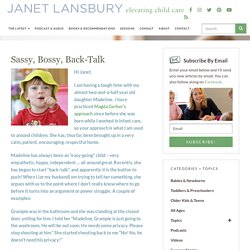
I have practiced Magda Gerber’s approach since before she was born while I worked in infant care, so your approach is what I am used to around children. She has, thus far, been brought up in a very calm, patient, encouraging, respectful home. Madeline has always been an “easy-going” child – very empathetic, happy, independent … all around great. Putting an End to Power Struggles with Our Kids - Janet Lansbury. With the knowledge that it almost certainly takes two to tango, it should be easy for us to avoid engaging in power struggles with our kids, right?
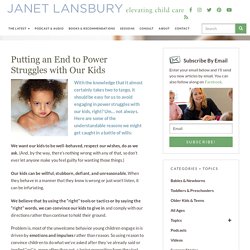
Um… not always. Here are some of the understandable reasons we might get caught in a battle of wills: We want our kids to be well-behaved, respect our wishes, do as we ask. (And, by the way, there’s nothing wrong with any of that, so don’t ever let anyone make you feel guilty for wanting those things.) Is screen time bad for babies and toddlers?
Once your child is at least 18 months old, it's okay for him to spend a little time watching a high-quality show or playing a fun app with you.
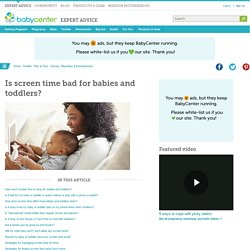
But for babies younger than that, screen time doesn't seem to offer any real benefits – and it could lead to health and developmental problems down the road. In addition to thinking about how your child will use a screen, it's also important to pay attention to how much screen time is okay. Read on to find out what the experts say. How much screen time is okay for babies and toddlers? The American Academy of Pediatrics (AAP) recommends keeping all screens off around babies and toddlers younger than 18 months. Ghid practic 3. Why does my toddler love repetition? - BabyCentre UK. Paediatric speech and language therapist It may test your patience when your toddler demands 'Row, row, row your boat' for the 10th time.
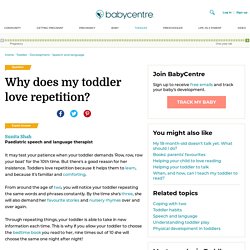
But there's a good reason for her insistence. Toddlers love repetition because it helps them to learn, and because it's familiar and comforting. From around the age of two, you will notice your toddler repeating the same words and phrases constantly. By the time she's three, she will also demand her favourite stories and nursery rhymes over and over again.
Through repeating things, your toddler is able to take in new information each time. How can I help my child to start talking? (Video) - BabyCentre UK. Health visitor Sara Patience describes how you can help develop your child's language skills by talking and playing with her.
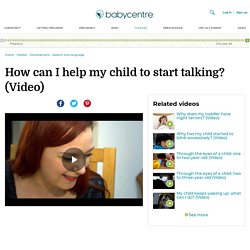
Show transcript Hide transcript How can I help my child to start talking? Sara: “You want this one? Let's Talk. What do babies need in order to learn and thrive? One thing they need is conversation — responsive, back-and-forth communication with their parents and caregivers. This interactive engagement is like food for their developing brains, nurturing language acquisition, early literacy, school readiness, and social and emotional well-being. A dispiriting number of children don’t get that kind of brain-fueling communication, research suggests. In early childhood policy (and in the wider media), much attention has been paid to the so-called word gap — findings that show that low-income children hear 30 million fewer words, on average, and have less than half the vocabulary of upper-income peers by age three. But putting that alarming number in the spotlight obscures a more critical component of the research, says Harvard Graduate School of Education literacy expert Meredith Rowe: it’s not so much the quantity of words but the quality of the talk that matters most to a child’s development.
Listen to Your Mother. Young children face a remarkable challenge in learning to use the language of their culture. Toddlers vary widely, however, in the rate at which they learn new words.1 A team of Harvard Graduate School of Education researchers set out to ask whether and how children's language environment can impact vocabulary development. In their study of mother-child pairs from low-income families, they found that mothers who used many different words (not just many words) had toddlers with faster growth in vocabulary use. Deb Roy: The birth of a word.
Early childhood development – it’s not rocket science, it’s neuroscience! - Kathy Brodie Early Years Training. I was introduced to Mine Conkbayir when she contacted me about neuroscience informing early years practice, which I think is such an exciting, and growing, area of study.
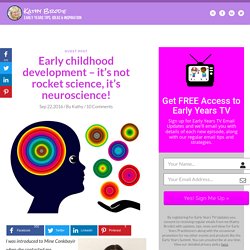
So I was very enthusiastic when she offered to do a guest post on this subject. Here she discusses how neuroscience can add another dimension to our understanding of child development: Like many individuals in this increasingly frantic world, I’m often busy juggling my responsibilities as a parent while I work and continue my studies – a very exciting journey as I try to achieve my PhD in early childhood education and neuroscience. Having been a lecturer across a range of child care and education qualifications for the past 14 years, I continue to be bewildered by the lack of consistently embedded teaching of neuroscience and early brain development across these qualifications. You may well ask ‘how?’ How do you speak 'Motherese'?
Free-flow play. Advice for developing language. Play. Play. Does my toddler have a short attention span because she won’t sit still for a story? A: It is perfectly normal for toddlers to not sit still very long—period.
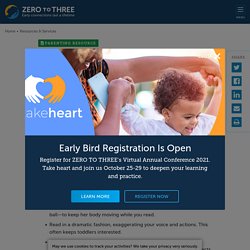
Most don’t like to stay in one place for long now that they can explore in so many new ways—by running, jumping, and climbing. So, an adult’s idea of snuggling on the couch to hear a story may not be the same idea a toddler has for story-time. You may only be able to read or talk about a few pages in a book at a time. I Said I Want the Red Bowl! Responding to Toddlers' Irrational Behavior. Pin It Amelia, told that she can’t have a fifth book before bedtime, shouts: “You are the meanest mommy!

You are not invited to my birthday party!” Schemas in Children’s Play - N a t u r e P l a y. Written by Clare CaroSchemas in Children’s Play are such an important concept when it comes to the development of our children that it’s worth taking the time to understand them so you can facilitate them when you see them.What are these schemas?

Well it’s really a fancy word for the urges that children have to do things like climb, throw things and hide in small places. They appear through play; perhaps it is the way they choose to do things, or what they desperately need to do out of the blue! Bringing It All TogetherAfter looking at each schema individually to get to grips with what each 'urge' is all about we may already be able to recognise some of the different ways they can appear in your child.Rotation, Trajectory, Enveloping, Orientation, Positioning, Connection, Enclosure/Container, Transporting and Transformation are urges that show in all children starting as early as their first birthday, some times before.How Can Knowing About These Urges Help Us?
Schema and Fairies - Kathy Brodie Early Years Training. Schemas are one of those things that divide practitioners, like fairies at the bottom of the garden.
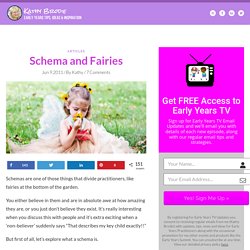
You either believe in them and are in absolute awe at how amazing they are, or you just don’t believe they exist. It’s really interesting when you discuss this with people and it’s extra exciting when a ‘non-believer’ suddenly says “That describes my key child exactly!!” But first of all, let’s explore what a schema is. The natives and the speakers. Let me start with the good news. We are, all of us without exception, native speakers. This may come as a surprise to those of us who have had close encounters with the second/foreign language world, but is nonetheless true. It means that we are all competent users of language – more or less competent, of course, depending on all sorts of individual and social factors that make us clumsy or proficient in whatever we do.
You speak with an accent. I don’t. Accents are things that only other people have. They are, by extension, things that you don’t want to have. Accents are, in short, shortcomings. This is why, if someone tells you that “you speak with no accent”, you can be sure of two things: that you have received words of praise indeed; and that you speak with the same accent as that person.
Teaching English to learners with Special Educational Needs (SENs) – Myths and realities. ‘I know I have children with special educational needs in my class, I want to help them and we are supposed to promote inclusion, but I really am not sure how to do this’ Vera, primary teacher from Spain ‘Some of the children in my class are really badly behaved, they can’t sit still, don’t finish their work and are always calling out. I think they might have a learning difficulty, but I don’t know what to do’ Kris, secondary teacher from Poland. Neurodiversity TfS online conference. B480 Special Need Publication A4 V5 Final MR.
Ey besd. FAQ: Raising Bilingual Children. Why want bilingual children? There are many reasons, but the two most common are: 1) The parents speak different languages (say, an American woman and a Turkish man). 2) The parents speak the same language, but live in a community where most people speak something else (say, a Korean couple living in the USA). One Person–One Language and Bilingual Children. Labelling children. How can parents and teachers best educate young children?
What principles can both teachers and parents bring to the education of very young children? Gillian Craig, who was part of the Learning Time with Shaun and Timmy writing team, explains. As teachers and parents, we follow certain principles in our roles. Carol Dweck: The power of believing that you can improve. Effective Teacher-Child Interactions. PowerfulInteractions. Talking with Babies and Toddlers June05. Examples. Practical tips. By Opal Dunn, educational consultant and author Introduction Young children learn English differently from most adults. Ey making mark matters76708 1. Short stories. How to teach children English using illustrated storybooks. What makes illustrated storybooks such a good resource for teaching young learners of English?
The British Council’s Gail Ellis, co-author of a storytelling handbook for primary English language teachers, explains. Songs. 45+ Quick & Easy Kids Crafts that ANYONE Can Make! - Happiness is Homemade. Music and Movement Activities for Toddlers and Preschoolers. 30 Favorite Toddler Songs. School Radio - Nursery songs and rhymes.
Whole Child Development Is Undervalued. How Are Happiness and Learning Connected? As teachers, we also know that when students' affective filters or defenses are sky high, fight or flight responses will be modus operandi. Why Empathy Holds the Key to Transforming 21st Century Learning. By Thom Markham Like other aspects of modern life, education can make the head hurt. Which Early Childhood Experiences Shape Adult Life? By Maanvi Singh, NPR. Can Free Play Prevent Depression and Anxiety In Kids? Don't Expect Toddlers To Behave Consistently — They Literally Can't. One theory all teachers with disruptive children should know about.
A 19-Year Study Reveals Kindergarten Students With These 2 Skills Are Twice as Likely to Obtain a College Degree (And They Have Nothing to Do With Reading) 21 Of The Best Early Years Books For International Friendship Day. This ‘Kindness Curriculum’ Is Free And Should Be Used In Every Classroom. Effective Teacher-Child Interactions. Information sheet Guidelines for documenting children s learning.
Observation, Assessment and Planning - Early Years Matters. Assessment for learning in ECE. Useful comments and conversations.